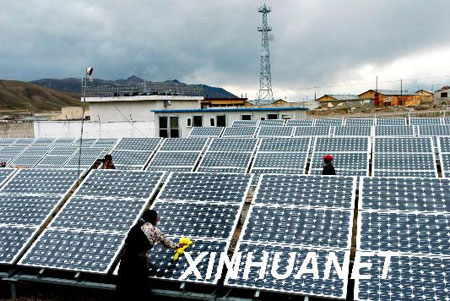The government of Nagqu Prefecture in northern Tibet plans to build this year another power station using wind power and solar energy as its energy source, with a generating capacity of 50 kw, according to Tibet Business.
Upon completion, the station will be the largest of its kind in Tibet and will supply electricity to 50 households for daily use, according to the Energy Research Pilot Center of Tibet Autonomous Region.

Photo taken in August 2006 shows herders in Gulu County, Nagqu Prefecture of southwest China's Tibet Autonomous Region using solar photovoltaic panels to generate electricity, photo from Xinhua.
To solve the problem of electricity for farmers and herders in remote rural areas, in 2000, the Tibet Regional Government built Tibet's first power station driven by wind power and solar energy in Lou Town, Nagqu County, according to Ciren Pingcuo, a staff with the center.
Today, there are seven such power stations in the region, providing electricity for 5,000 households of farmers and herders for domestic consumption.
The power generating system consists of generators driven by wind power and solar energy panels. During night time or on cloudy and rainy days, electricity would be generated by wind power. On sunny days, it will operate with the solar energy. While on a sunny and windy day, the two types of energy can work simultaneously.
Located about 4,500 meters above sea level, the Nagqu area receives more than 2,800 hours of sunshine each year.
As farmers and herders live scattered in rural areas, the wind power and solar energy power-generating system can distribute electricity capacity more reasonably in accordance with users' need as well as resources.
In addition, such a system can ensure the reliability of electricity supply and help reduce the cost of installing power generating systems.
The new power station will be built in Geduo Village, Lu Town in Nagqy County, said Ciren Pingcuo. The village has 43 households with 169 residents. The completion of the project will meet the needs of all the households for electricity.
The project is set to begin in June and is expected to be completed at the end of August.
